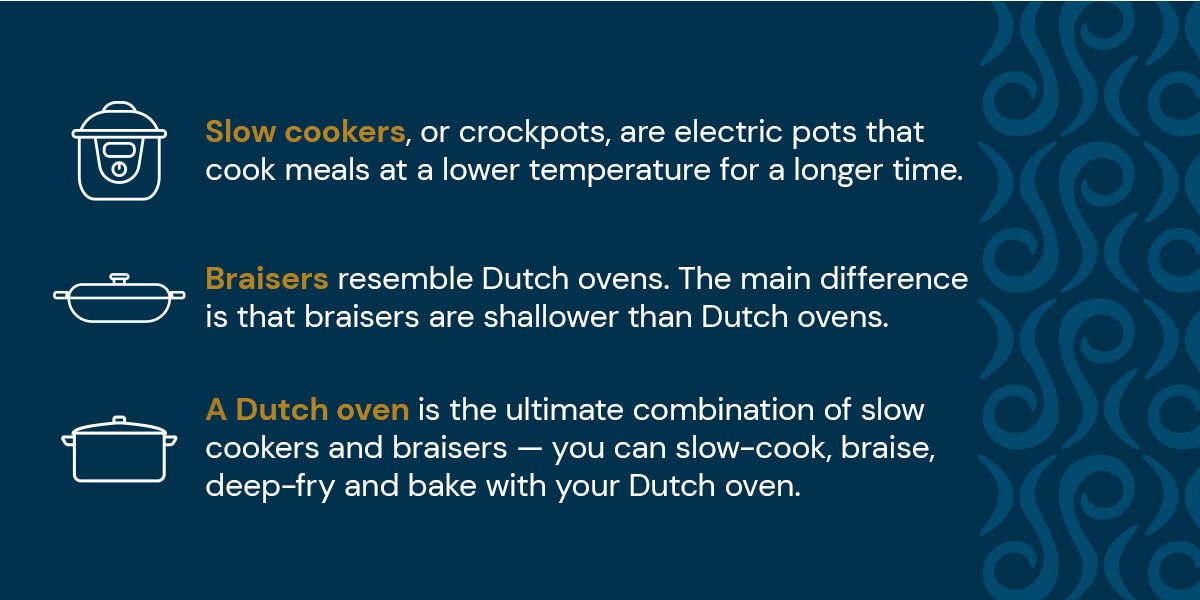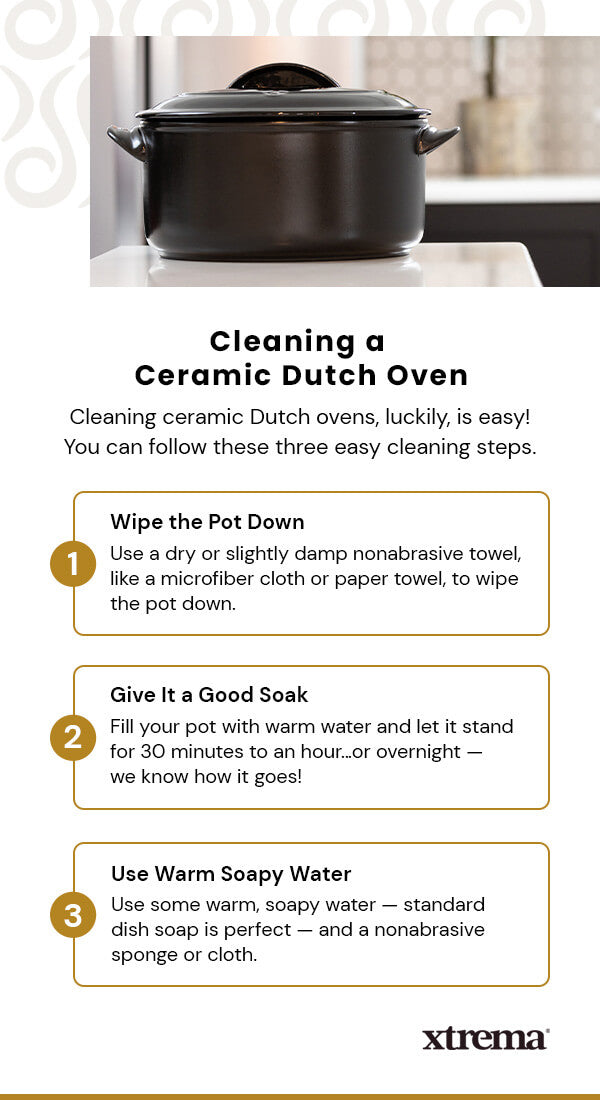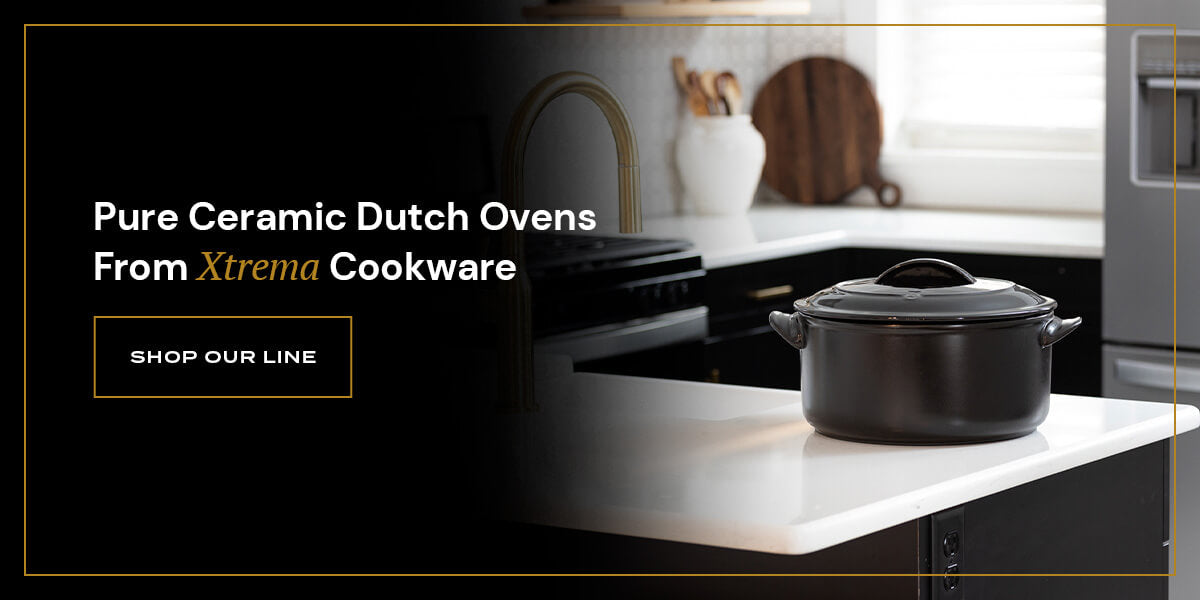
A Dutch oven is a proud feature in any kitchen — they distribute heat to cook food evenly, and they trap moisture to help you create flavorful, tender meals. Dutch ovens are also wonderfully versatile, perfect for braising, slow cooking, sauteing and deep-frying. You can even bake in a Dutch oven! Whether you are serving up casseroles, roasts, stews, breads or desserts, Dutch ovens are the ideal tool.
A pure-ceramic Dutch oven can last a lifetime when you care for it properly, and correct cleaning is an important part of maintenance. This comprehensive guide to cleaning Dutch ovens will give you all the insight and know-how you need to keep your Dutch oven in the best condition for years to come.
What Is a Dutch Oven?
A Dutch oven is a broad and heavy pot with thick walls and a tight-fitting lid. They also have handles on both sides that make them practical to move around. These pots are typically deep, making cooking perfectly juicy meats easy thanks to the even heat distribution. They're also durable and versatile, as you can use them on the stovetop and in the oven. Dutch ovens come in various sizes. A large pot makes it easy to cook for a large party and is ideal for meal prepping.
Dutch Oven vs. Braiser vs. Slow Cooker
Dutch ovens, braisers and slow cookers have some features in common. While you can use braisers and slow cookers for some of the same dishes as a Dutch oven, the Dutch oven certainly has more uses all around.

Slow cookers, or crockpots, are electric pots that cook meals at a lower temperature for a longer time. They usually have three heat settings — low, medium and high — and are very beneficial for new cooks since burning foods is difficult when set to the lowest setting. Crockpots are great for stewing and cooking meats like brisket and pork shoulder. Because slow cookers have an electric heating element, you must adhere to the recommended liquid level.
Braisers resemble Dutch ovens — both are hefty pans with lids and handles. The main difference is that braisers are shallower than Dutch ovens, and the braiser's walls are more rounded at the bottom. Additionally, as the name suggests, braisers are designed for braising foods, which involves browning or searing the food before simmering it in a small amount of water, stock or milk. This makes them ideal for meat and vegetable dishes.
A Dutch oven is the ultimate combination of slow cookers and braisers — you can slow-cook, braise, deep-fry and bake with your Dutch oven, making it an all-in-one solution for your kitchen. The oven's design is perfect for cooking on the stovetop or oven, so there are endless recipes to be made!
Types of Dutch Ovens
There are a variety of Dutch ovens differing in material, shape and size. Some are large and heavy, perfect for commercial kitchens, while others are small enough to cook individual meals or to take on a camping trip.
Common Materials for Dutch Ovens
There are four materials typically used for Dutch ovens:
- Stainless steel: Stainless steel products cook food quickly and are easy to clean with the right products. However, stainless steel cookware may leech heavy metals into food.
- Bare cast iron: Bare cast iron keeps heat well and distributes heat evenly. Cast iron also withstands high temperatures, so you can even place it on an open fire for outdoor cooking. One downside to cast iron Dutch ovens is that they can be reactive and do not work well with acidic ingredients like tomatoes. You must also care for your cast iron cookware with proper cleaning and seasoning.
- Enameled cast iron: As the name suggests, these are cast iron pots with an enamel coating. Enamel coated cast iron is pretty heavy, but it also stops the iron from altering the flavors of your food and makes the pot easier to clean.
- Ceramic: Ceramic is an excellent choice for any cookware product. Pure ceramic cookware is non-toxic and lighter than other cast iron — which is a real consideration when thinking about the heftiness of Dutch ovens! This cookware is also long-lasting, nonreactive, and easy to clean. When you clean them properly, these ceramic pots will not hold onto flavors or odors from previous dishes. Ceramic cookware also maintains heat well and distributes it evenly.
Cleaning a Ceramic Dutch Oven
A Dutch oven is an investment you can pass down for generations if you properly maintain it. Knowing how to clean and store your Dutch oven is essential for keeping its integrity. A good cleaning routine will vary depending on the type of Dutch oven you own. Some Dutch ovens, like cast iron pots, have specific cleaning instructions that you must follow to prevent damaging the cookware. Cleaning ceramic Dutch ovens, luckily, is easy! You can follow these three easy cleaning steps.

1. Wipe the Pot Down
Use a dry or slightly damp nonabrasive towel, like a microfiber cloth or paper towel, to wipe the pot down. As with any kitchen appliance, wiping your cookware immediately after cooking is always best. During this step, avoid scrubbing at any stubborn spots or stains. The wipe-down is a preliminary measure that makes it easier to get rid of those stains later.
2. Give It a Good Soak
If you've just made and enjoyed a particularly sticky meal or see food hardened inside the pot, it's time to give it a good soak. Fill your pot with warm water and let it stand for 30 minutes to an hour…or overnight — we know how it goes! Any dried food or stubborn stains should wipe away easily once you drain the water from the pot. Repeat this process if you still see tough spots, and leave the pot to soak for a little longer.
3. Use Warm Soapy Water
The final step to getting your ceramic Dutch oven as spotless as can be is to use some warm, soapy water — standard dish soap is perfect — and a nonabrasive sponge or cloth. This sponge or cloth will protect your pot. After you've cleaned the pot, wipe it dry with a paper towel or a soft cleaning cloth before storing it.
Cleaning Tips for Non-Ceramic Dutch Ovens
If you have a stainless steel, cast iron or enamel-coated Dutch oven, you will want to be careful about the cleaning supplies and methods you use so you can protect and maintain your pot. Here's some tips for cleaning a dutch oven that's not made of ceramic:
- Tools: Only use non-metal scrubbing pads or nonabrasive sponges to clean stainless steel cookware. Do not use any metallic scrubs or cleaning items on stainless steel.
- Cleaners: Use stainless steel cleaner for stubborn bits or stains.
- Drying: Dry stainless steel immediately after washing to prevent rust or visible water spots. You can also place the dish in the oven for a few minutes to evaporate any remaining droplets.
- Soaking: Avoid soaking a bare cast iron Dutch oven in water for too long, as its seasoning coats the oven so it does not rust. After a deep clean, you may need to season a cast iron oven again.
- Handling: Handle enamel-coated Dutch ovens carefully while cleaning to prevent chips or scratches.
- Scrubbing: Enamel-coated Dutch ovens can become stained from some ingredients like tomato sauces or pastes. The stain may not come off quickly, and that's OK. It's better to have a stained pot than to scrub the coating off and make it lose its nonstick properties.
- Handwashing: Opt to handwash your Dutch oven rather than place it in the dishwasher, even if it's labeled as dishwasher-safe.
Cleaning a Burnt Dutch Oven
Dutch ovens are excellent for cooking meals like stews because they retain and distribute heat really well. You rarely need to cook using a high-heat setting, which is great because doing so may cause the pot to burn.
If your Dutch oven is burnt, cleaning it is easy. You can try a natural cleaning solution to clean a burnt Dutch oven:
- Let the Dutch oven cool down first before washing it.
- Fill the Dutch oven with warm water and a few tablespoons of baking soda. You can also fill the pot with a solution that is equal parts water and white vinegar.
- Place the Dutch oven on the stovetop and bring the water to a simmer for about 10 minutes.
- Let the water cool before using a soft cloth to wipe the inside of the pot.
- Drain the cleaning solution, rinse with lukewarm tap water and let dry.
If all else fails, try a little oven cleaner!
Storing a Dutch Oven
Storing your oven properly goes a long way to keeping it neat and tidy. Here are some Dutch oven storing tips:
- Make sure the dish is completely dry before you store it.
- Keep the lid stacked away from the dish so that it can air when not in use.
- These pots can be heavy, so store them on a lower shelf to prevent accidents!
Benefits of a Ceramic Dutch Oven

Having a Dutch oven is an investment that comes with awesome advantages:
- Versatility: Dutch ovens are one of the most versatile pots — you can cook food on the stovetop and in the oven. You can even take your Dutch oven with you when you go camping to cook meals over a fire.
- Durability: Dutch ovens are durable pots that can last a lifetime, giving you great value for money.
- Ease of use: Dutch ovens are easy to use once you get the hang of it!
- Variety of meals: Perhaps the best part of having a Dutch oven is the variety of flavorful meals you can cook in it. You can enjoy the most tender meats, succulent chicken meals, beautifully braised vegetables, delicious homemade breads, and everyday dishes.
Cleaning Your Dutch Oven FAQ
Become a Dutch oven cleaning pro by exploring the answers to these common questions.
How Long Can I Wait Before Cleaning a Dutch Oven After Cooking?
While you can always clean your pot regardless of how long you have waited, cleaning your Dutch oven soon after cooking is always best! The longer you wait to clean the oven, the tougher the stains and dried particles will be to clean. Of course, it's also more hygienic to clean the pot soon after cooking to prevent bacteria from forming on leftover food.
What Kinds of Cleaning Products Can I Use on My Dutch Oven?
Use gentle cleaning products — like household dish soaps — on all Dutch ovens to maintain your dish and ensure it lasts. Natural cleaning solutions like water and white vinegar or baking soda are effective, sustainable and non-toxic.
There are a few more cleaning basics to consider that apply to all Dutch ovens, regardless of their material. Always ensure that you use nonabrasive scrubs or cloths, protect your Dutch oven by avoiding excessive scrubbing, and follow the manufacturer's manual to care for your specific oven accordingly.
Can I Place My Dutch Oven in the Dishwasher?
Some manufacturers of enameled Dutch ovens may note that you can place your Dutch oven in the dishwasher, but this is generally not advisable. Placing the pot in a dishwasher is unnecessary and can also cause damage to the pot — and this is especially true for cast iron and stainless steel Dutch ovens.
The chemicals from the dishwasher will break down a cast iron oven's seasoning, which will cause the pot to become porous and rust, lose its nonstick properties, and get scratched or chipped. Enameled Dutch ovens may be "safer" in a dishwasher, but they will certainly become duller inside and out if placed in the dishwasher.
How Do I Know It's Time to Replace My Dutch Oven?
When you care for your Dutch oven properly — especially a pure ceramic oven — you won't need to replace it for many years! However, you may need to replace your Dutch oven if you notice the following:
- The pot is badly scratched, or the enamel is chipped.
- Your cast-iron or stainless steel pot is rusted.
- The pot is severely stained or burnt, and you can no longer clean it effectively.
Pure Ceramic Dutch Ovens From Xtrema Cookware
Cooking using a Dutch oven is a simple way to elevate your culinary skills and serve healthy, flavorful meals. Whether serving up bread, a casserole or some delicious stew, you can count on your Dutch oven. When you care for your Dutch oven with proper cleaning techniques, gentle products and effective storage methods, it can last for generations.
Make ceramic cookware and bakeware a staple in your home with a Dutch oven and a range of ceramic kitchen items from Xtrema Cookware. We make your health, well-being and happiness in the kitchen a top priority, and our pure ceramic cookware is non-toxic, versatile and an investment for life.
Shop our line of quality ceramic cookware and bakeware items today!








